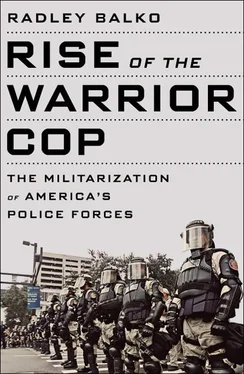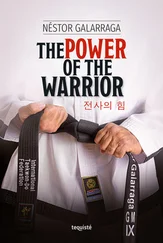If even the earliest attempts at centralized police forces would have alarmed the Founders, today’s policing would have terrified them. Today in America SWAT teams violently smash into private homes more than one hundred times per day. The vast majority of these raids are to enforce laws against consensual crimes. In many cities, police departments have given up the traditional blue uniforms for “battle dress uniforms” modeled after soldier attire. Police departments across the country now sport armored personnel carriers designed for use on a battlefield. Some have helicopters, tanks, and Humvees. They carry military-grade weapons. Most of this equipment comes from the military itself. Many SWAT teams today are trained by current and former personnel from special forces units like the Navy Seals or Army Rangers. National Guard helicopters now routinely swoop through rural areas in search of pot plants and, when they find something, send gun-toting troops dressed for battle rappelling down to chop and confiscate the contraband. But it isn’t just drugs. Aggressive, SWAT-style tactics are now used to raid neighborhood poker games, doctor’s offices, bars and restaurants, and head shops, despite the fact that the targets of these raids pose little threat to anyone. This sort of force was once reserved as the last option to defuse a dangerous situation. It’s increasingly used as the first option to apprehend people who aren’t dangerous at all.
There’s now a dominant military culture within modern police agencies. Go to one of the many SWAT conferences and SWAT team competitions held throughout the year and you’ll find exhibit halls teeming with military weapons, gear, clothing, and imagery. The vendors at these events know their market. They use war imagery to ply their goods because that’s what makes cops and police departments want to buy them. Many sell the same products to both the military and civilian police agencies. In the 1990s and 2000s, the company Heckler and Koch marketed its MP5 semi-automatic weapon with the slogan “From the Gulf War to the Drug War—Battle Proven.” 6Publications like Larry Flynt’s SWAT magazine feature ads that emphasize knocking heads and kicking ass, and print articles with headlines like “Go for the Throat” and “Warrior Mindset.”
There’s been nothing secretive about this transformation, but because it’s been unfolding over several decades, we don’t seem to have noticed. On February 11, 2010, in Columbia, Missouri, the police department’s SWAT team served a drug warrant at the home of Jonathan Whitworth, his wife, and their seven-year-old-son. Police claimed that eight days earlier they had received a tip from a confidential informant that Whitworth had a large supply of marijuana in his home. They then conducted a trash pull, which turned up marijuana “residue” in the family’s garbage. That was the basis for a violent, nighttime, forced-entry raid on the couple’s home. The cops stormed in screaming, swearing, and firing their weapons, and within seconds of breaking down the door they intentionally shot and killed one of the family’s dogs, a pit bull. At least one bullet ricocheted and struck the family’s pet corgi. The wounded dogs whimpered in agony. Upon learning that the police had killed one of his pets, Whitworth burst into tears.
The Columbia Police Department SWAT team recorded many of its drug raids for training purposes, including this one. After battling with the police over its release, a local newspaper was finally able to get the video through state open records laws and posted it to the Internet. It quickly went viral, climbing to over one million YouTube views within a week. People were outraged. The Columbia Police Department was swamped with phone calls and emails, and its officers were condemned, cursed, and scolded. Some even received death threats.
The video also made national headlines. On Fox News, Bill O’Reilly discussed it with newspaper columnist and pundit Charles Krauthammer, who assured O’Reilly’s audience that botched raids like the one in the video were unusual; he warned viewers not to judge the war on drugs based on the images coming out of Columbia. Krauthammer was wrong. This was not a “botched” raid. In fact, the only thing unusual about the raid was that it was recorded. Everything else—from the relatively little evidence to the lack of a corroborating investigation, the killing of the dog, the fact that the raid was for nothing more than pot, the police misfiring, and their unawareness that a child was in the home—was fairly standard. The police raided the house they intended to raid, and they even found some pot. The problem for them was that possession of small amounts of pot in Columbia had been decriminalized. They did charge Whitworth with possession of drug paraphernalia for the pipe they found near the marijuana—a $300 fine.
The reaction to the video was fascinating—and perhaps encouraging—because, again, the raid itself was indistinguishable from the tens of thousands of similar raids conducted each year in America. It was as if the country—or at least the Internet generation—was for the first time seeing firsthand, on-the-ground footage of the way the drug war is fought every day. And they found it terrifying.
Most Americans still believe we live in a free society and revere its core values. These principles are pretty well known: freedom of speech, religion, and the press; the right to a fair trial; representative democracy; equality before the law; and so on. These aren’t principles we hold sacred because they’re enshrined in the Constitution, or because they were cherished by the Founders. These principles were enshrined in the Constitution and cherished by the Framers precisely because they’re indispensable to a free society. This book answers the question: How did we get here? How did we evolve from a country whose founding statesmen were adamant about the dangers of armed, standing government forces—a country that enshrined the Fourth Amendment in the Bill of Rights and revered and protected the age-old notion that the home is a place of privacy and sanctuary—to a country where it has become acceptable for armed government agents dressed in battle garb to storm private homes in the middle of the night—not to apprehend violent fugitives or thwart terrorist attacks, but to enforce laws against nonviolent, consensual activities? How did a country pushed into a revolution by protest and political speech become one where protests are met with flash grenades, pepper spray, and platoons of riot teams dressed like Robocops? How did we go from a system in which laws were enforced by the citizens, often with noncoercive methods, to one in which order is preserved by armed government agents too often conditioned to see streets and neighborhoods as battlefields and the citizens they serve as the enemy?
Before we begin, a few organizational notes are in order. First, this is not an “anti-cop” book. Although it includes plenty of anecdotes about bad cops, there are plenty of good cops. Some of them are interviewed in this book. The fact is that we need cops, and there are limited situations in which we need SWAT teams. If anything, this is an anti-politician book. Bad cops are the product of bad policy. And policy is ultimately made by politicians. A bad system loaded with bad incentives will unfailingly produce bad cops. The good ones will never enter the field in the first place, or they will become frustrated and leave police work, or they’ll simply turn bad. At best, they’ll have unrewarding, unfulfilling jobs. This book explores the consequences of having cops who are too angry and too eager to kick down doors and who approach their jobs with entirely the wrong mind-set, but with an eye toward identifying and changing the policies that allow such people to become cops in the first place—and that allow them to flourish in police work.
Читать дальше












